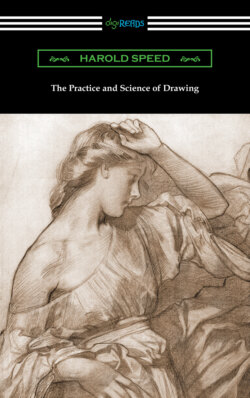Читать книгу The Practice and Science of Drawing - Harold Speed - Страница 25
На сайте Литреса книга снята с продажи.
ОглавлениеThe visual blindness of the majority of people is greatly to be deplored, as nature is ever offering them on their retina, even in the meanest slum, a music of colour and form that is a constant source of pleasure to those who can see it. But so many are content to use this wonderful faculty of vision for utilitarian purposes only. It is the privilege of the artist to show how wonderful and beautiful is all this music of colour and form, so that people, having been moved by it in his work, may be encouraged to see the same beauty in the things around them. This is the best argument in favour of making art a subject of general education: that it should teach people to see. Everybody does not need to draw and paint, but if everybody could get the faculty of appreciating the form and colour on their retinas as form and colour, what a wealth would always be at their disposal for enjoyment! The Japanese habit of looking at a landscape upside down between their legs is a way of seeing without the deadening influence of touch associations. Thus looking, one is surprised into seeing for once the colour and form of things with the association of touch for the moment forgotten, and is puzzled at the beauty. The odd thing is that although thus we see things upside down, the pictures on our retinas are for once the right way up; for ordinarily the visual picture is inverted on the retina, like that on the ground glass at the back of a photographic camera.
To sum up this somewhat rambling chapter, I have endeavoured to show that there are two aspects from which the objective world can be apprehended. There is the purely mental perception founded chiefly on knowledge derived from our sense of touch associated with vision, whose primitive instinct is to put an outline round objects as representing their boundaries in space. And secondly, there is the visual perception, which is concerned with the visual aspects of objects as they appear on the retina; an arrangement of colour shapes, a sort of mosaic of colour. And these two aspects give us two different points of view from which the representation of visible things can be approached.
When the representation from either point of view is carried far enough, the result is very similar. Work built up on outline drawing to which has been added light and shade, colour, aerial perspective, &c., may eventually approximate to the perfect visual appearance. And inversely, representations approached from the point of view of pure vision, the mosaic of colour on the retina, if pushed far enough, may satisfy the mental perception of form with its touch associations. And of course the two points of view are intimately connected. You cannot put an accurate outline round an object without observing the shape it occupies in the field of vision. And it is difficult to consider the “mosaic of colour forms” without being very conscious of the objective significance of the colour masses portrayed. But they present two entirely different and opposite points of view from which the representation of objects can be approached. In considering the subject of drawing I think it necessary to make this division of the subject, and both methods of form expression should be studied by the student. Let us call the first method Line Drawing and the second Mass Drawing. Most modern drawing is a mixture of both these points of view, but they should be studied separately if confusion is to be avoided. If the student neglects line drawing, his work will lack the expressive significance of form that only a feeling for lines seems to have the secret of conveying; while, if he neglects mass drawing, he will be poorly equipped when he comes to express form with a brush full of paint to work with.
